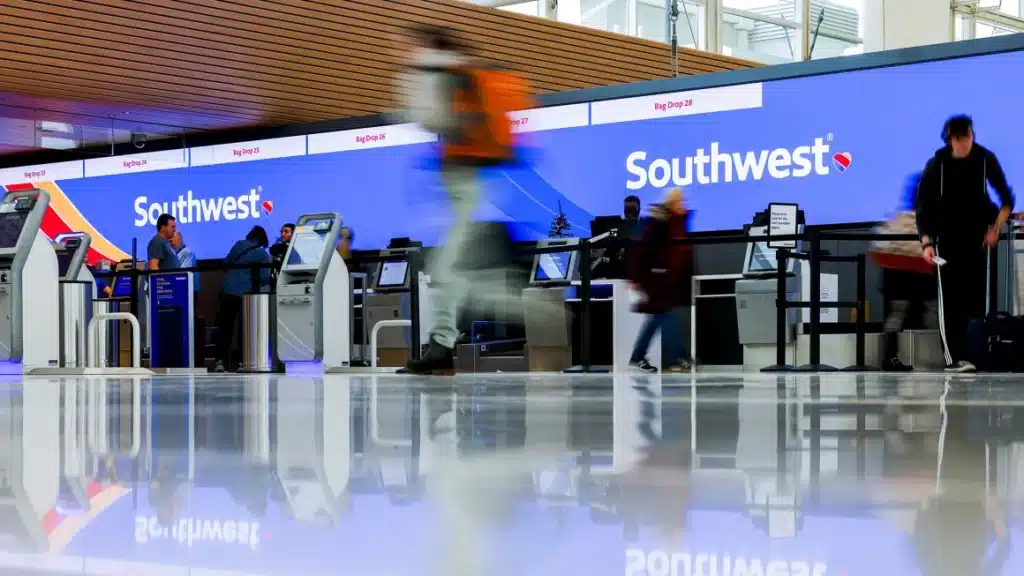As of Monday afternoon, the airline had canceled more than 700 flights, about 18% of its schedule, setting off alarm bells that the nightmarish travel weekend could be the start of another operational fiasco for the company.
However, the airline claims that this is not a technological problem, unlike the 10-day service outage that cost the business over a billion dollars and left over 2 million passengers stranded during the 2022 holiday season.
The weather is the issue. This weekend, a wide region of the nation was hit hard by severe winter weather, and over 140 million people are currently under wind chill advisories that extend from the Rockies to central Texas. From Oregon to Mississippi, over 140 daily cold records might be broken on Monday and Tuesday. Memphis, Dallas, and Nashville are predicted to have below-freezing temperatures for a minimum of 72 hours straight.
According to Southwest, the delays were prearranged and informed to consumers beforehand. A spokesperson for the airline told CNN in a statement that the schedule adjustments were made “to anticipate forecasted operating conditions across a wide swath of our route map – everything from wintry precipitation including blizzard conditions, to airfield and airspace constraints, and dangerous wind chill environments that require rotating ground crews to limit exposure.”
The representative stated that “as the storm moves East and the cold temperatures begin to moderate,” cancellations and delays should significantly decrease on Tuesday. The airline provided a number of operational measures, such as upgrades to crew scheduling systems and additional de-icing equipment at airports, that it claims it took in 2023 to make sure the degree of disruption that occurred in 2022 does not happen again.
Southwest Airlines claims that, in contrast to the 2022 holiday travel crisis, the recent round of cancellations is primarily down to the airports it flies into and out of rather than technological difficulties, and that, unlike the previous occurrence, it should bounce back swiftly.
At certain airports, Southwest is a significant carrier; nonetheless, the country as a whole is currently paralyzed by an Arctic blast. It is especially prevalent in Dallas, which the National Weather Service warns might experience hazardous winter conditions this week, and Chicago and Denver, both of which are under wind chill advisories.And Southwest isn’t the only airline that has found the icy conditions challenging. American Airlines requested a ground stop at Dallas/Fort Worth International Airport earlier Monday morning. “The ground stop from earlier was a temporary effort to alleviate the lines at the de-icing pads and free up space at the gates for inbound aircraft during our busiest arrival bank at DFW,” the airline told CNN.
Over the extended weekend, there were significant delays due to the persistent winter weather. According to FlightAware, there were around 3,000 cancellations and over 16,500 flight delays on Saturday and Sunday throughout the United States. According to FlightAware data, Monday had the highest number of cancellations since the Southwest collapse in late 2022, surpassing 3,000, and more than 8,600 flights were postponed.
With over 760 canceled flights, Southwest is the airline most affected, followed by United with over 430 canceled flights.
According to FlightAware data, more than 700 flights have been canceled on Tuesday as of yet.
The already challenging week for airlines and their customers is being made worse by these weather-related delays. The federally ordered grounding of Boeing 737 Max 9 aircraft resulted in the cancellation of almost 200 daily flights operated by United and Alaska Airlines last week. After a section of the fuselage burst off an Alaska Airlines flight on January 5 with 177 people on board, the Federal Aviation Administration reinstated the directive. Not long after takeoff from Portland, Oregon, the incident tore headrests off seats and caused a massive hole in the side of the aircraft. The plane was flying at 16,000 feet.
Based on the Anuvu Pulse industry dashboard, United and Alaska Airlines—the two biggest US carriers that operate the Max 9 aircraft—are among the airlines that are canceling the most flights. With over 13% of its flights canceled, United is the second most affected airline after Southwest, which does not operate any Max 9 aircraft. With 15% of its scheduled flights canceled on Sunday, Alaska Airlines had the third-highest cancellation rate.
Last Monday, both airlines announced that all of their Max 9 flights have been canceled through the middle of January.

